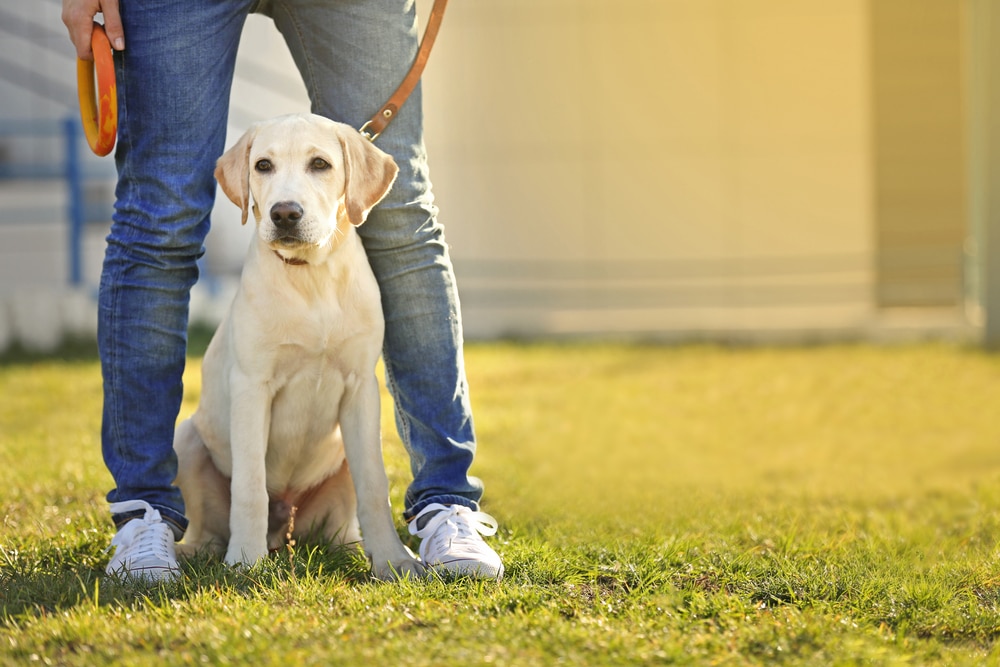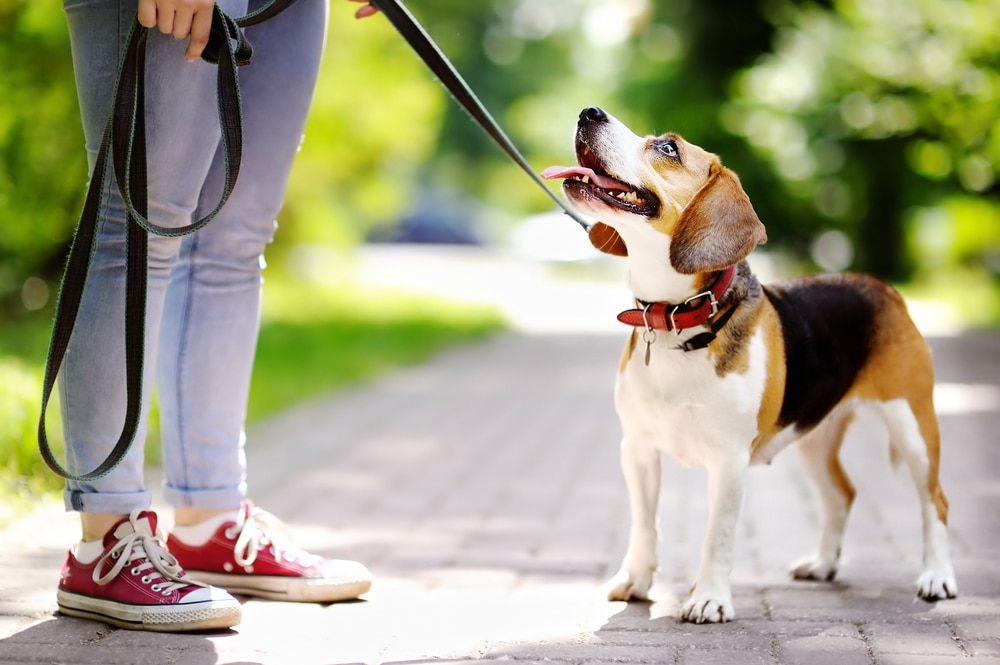Being a dog owner is a continuous adventure, as dogs are free souls who love moving around. But sometimes this freedom can give you an unwanted headache. So, should you put your dog on a leash? Will this help?
Your dog should always be on a leash when outside your home, and as much as possible besides that too, especially when in a public place as this is a law referred to as “leash law” in many communities. This law is meant to keep both public and your dog safe from harmful and unwelcome incidents. It also helps to keep your dog from accessing areas that may lead to it getting dirty or lost. Additionally, with the leash on your dog, you have more control and can quickly respond to any situation as needed.
Table of Contents
- What If Your Dog Is Off The Leash?
- Why Keep Your Dog On A Leash
- The Leash Law
- Prevent It From Attacking Others
- Protection From Road Accidents
- It Stops Your Dog From Getting Dirty
- Indicates Your Dog Is A Pet
- Safety For Neighbors
- Prevention From Getting Diseases
- Prevention From Eating Garbage, Non-Edible, And Public Offerings
- Prevents Them From Getting Lost
- Ease in Greetings
- What If You Keep Your Dog On A Leash At All Times
- How To Leash Train Your Samoyed
- In Conclusion: Should I Put My Dog On A Leash?
What If Your Dog Is Off The Leash?
If your dog is off the leash, you will have significantly less control over it and are liable for any damages that may arise. Your dog can also easily wander off and get into dangerous situations such as getting hit by a car.
In addition, without a leash, it may be difficult to introduce your dog to other people and pets walking alongside you.
Why Keep Your Dog On A Leash

We’ll start with the leash law.
The Leash Law
In almost every community, there is a law called the “leash law.” This law says dogs must be on a leash at all times when in a public place and must be under the control of their owners when in a private place.
It is important to abide by the leash law. If your dog is off the leash and causes harm or destruction of property, you are responsible for it.
Prevent It From Attacking Others
Every dog, regardless of breed or size, has the potential to become aggressive. While it is important to socialize with your pet and teach it good behavior, it is impossible to always predict when a dog may become aggressive.
Keeping your dog on a leash can help you control it and prevent it from attacking someone or another pet. When a dog gets aggressive, it is easy to pull it back and keep the situation under control.
Protection From Road Accidents
Sometimes even well-trained dogs run in a path of a fast-moving car and get hit by it. This is a terrible situation for all dog lovers.
A leash will provide you with a chance to protect your dog’s life as it is often considered a dog’s lifeline.
It Stops Your Dog From Getting Dirty
If you allow your dog to wander in a park or any other place, it will make itself dirty by jumping and playing where it shouldn’t. No one wants to put extra effort into frequently bathing their dog as it costs them both your time and money.
Indicates Your Dog Is A Pet
A leash is an important marker on your dog, as it tells the difference between a pet and a stray dog. And walking with a well-trained dog and having a leash on is always a pleasure to watch.
It helps in reuniting you with your dog too by marking it as a pet if you get separated.
Safety For Neighbors
Having a leash on your dog will protect your neighbor’s property from being damaged by your dog during walking. It also provides you control over your dog to prevent jumping on your neighbor as well.
Prevention From Getting Diseases
If you allow your dog to move freely, it may eat something which it is not supposed to eat, such as other animals’ poop or garbage, which can contain diseases and make your dog ill.
Keeping it on a leash helps prevent your dog from eating things that may make it sick.
Prevention From Eating Garbage, Non-Edible, And Public Offerings
Dogs usually sniff around and whenever they come across something that smells good, they will try to eat it. However, some of these things can make them very sick and can even cause a trip to the veterinarian.
Leashes will help prevent your dog from eating garbage, non-edible items, and food offered by the public.
Prevents Them From Getting Lost
Dogs are naturally curious, and they love to explore their surroundings. They can easily get distracted by a passing car, animal, or even a tasty snack and wander off without you noticing.
Leashes keep your dog close to you so that if it does become distracted, you can easily stop it from going too far and control its movements
Ease in Greetings
When your dog is leashed, other leashed dogs can greet each other calmly. By being close to you, your dog knows you are with it and can safely sniff other dogs or people without fear.
If your dog shows any signs of aggression, you can pull it back quickly and easily. This allows for friendly interactions between your dog and other dogs while still maintaining safety.
What If You Keep Your Dog On A Leash At All Times
Keeping your dog on a leash at all times can have many negative effects. It can make your pet depressed and lead to serious aggression when it becomes annoyed or frustrated.
Not only that, but if your dog is on a leash all the time, it may start to hold its pee or poop since it is not able to go outside and relieve itself. This can lead to serious complications and health issues if it’s not taken care of immediately. A well-trained dog should be able to go outside and relieve itself in an assigned spot.
Therefore, it’s important to make sure your dog has enough freedom and independence when possible, or else you may regret it in the long run.
How To Leash Train Your Samoyed
Let’s start with introductions.
1. Introduce Your Samoyed To The Leash And Collar
The first step in leash training your Samoyed is to introduce it to its collar and leash. Start by allowing your dog to get used to the sensation of wearing a collar and walking with a leash.
Be sure to choose the right size collar and make sure it is comfortable for your Samoyed. If it seems uncomfortable or upset, try a different size collar and continue adjusting until your pet is comfortable.
2. Teach Your Dog A Cue
Once your Samoyed is comfortable wearing a collar and leash, the next step is to teach it a cue. This can be done by saying a command such as “come” when you want your Samoyed to come toward you. Hold the end of the leash and give it a treat when it arrives.
You should continue this process until your dog remembers the cue and comes to you when called.
3. Start With Indoor Training
Before taking your dog on a walk, start by training it indoors. This will help it become familiar with how the leash works and also get used to walking with it. Start by allowing your pet to walk around the house on a short leash and give it treats when it does well.
4. Take Your Samoyed Outside
Once your Samoyed is comfortable walking with the leash indoors, it’s time to take it outside. Start by taking short walks and gradually increase the length and difficulty of the walks. You should also work on teaching your pet to walk calmly by your side, rather than pulling ahead or lagging behind.
It’s important to remain patient and consistent during the training process, as it can take some time for your Samoyed to get used to the leash. As long as you stay positive and provide plenty of treats, your Samoyed should eventually learn how to walk calmly on a leash.
In Conclusion: Should I Put My Dog On A Leash?
It’s important to keep your dog on a leash, as it can be dangerous for it to roam around freely. However, it’s also important to make sure your pet has freedom and independence whenever and wherever possible.
By following the steps outlined above, you can ensure your Samoyed is properly leash trained so it can enjoy its walks while remaining safe.
So, what do you think about leash training? Ready to start or want to stay away? Let us know your thoughts and why in the comments below!
